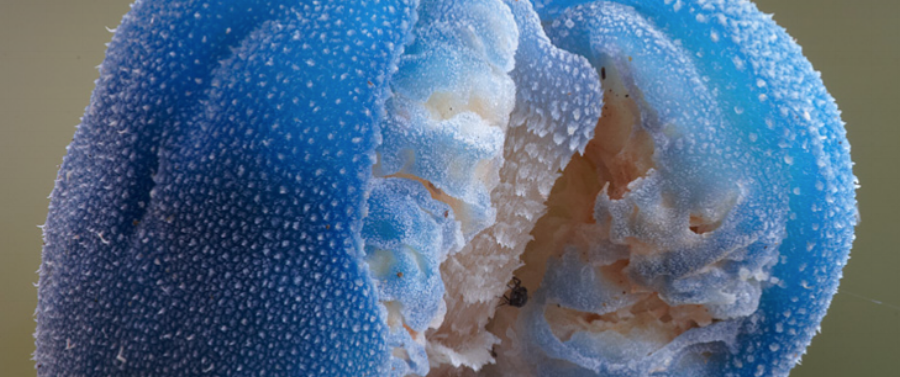
"The effects of arbuscular mycorrhiza fungi (AMF) infection on the growth of Oil Palm seedlings in nursery trials showed that the seedlings treated with Glomus etunicatum soil inocula resulted in 80.36% increased growth response."
SUNDRUM, SHAMALA* MPOB (2010). Growth effects by arbuscular mycorrhiza fungi on oil palm seedlings. Journal of Oil Palm Research Vol. 22
MycoSpora™: Arbuscular Mycorrhizal Fungi (AMF)
Control Ganoderma, Start Seedlings Strong & Reduce Your Fertiliser Bill
Arbuscular Mycorrhizal Fungi (AMF) create structures within root cells called arbuscules that facilitate the transfer of nutrients between the plant and the fungus.
AMF colonises the roots of the target host, due to their significantly smaller extra radical hyphae diameter to that of the plant’s root hair.
Their maze of hyphae filaments effectively increases the original surface area of the roots by up to 1000% with a remarkably productive outcome. Root benefits are magnified tenfold and the plant is perfectly positioned to achieve its true genetic potential.
Studies show that AMF has the ability to improve the plant’s resistance to diseases, pests and environmental stresses, most importantly helping the industry manage Ganoderma Boninense.
AMF realises further economic benefits by reducing the amount of 'wasted fertilisers', allowing companies to slowly reduce their fertiliser applications. AMF has the ability to secrete organic acids that aid in the chelation of ions in the soil, promoting better nutrient recovery.
The extensive use of chemicals and fertilisers has significantly increased crop yields across the agricultural spectrum. However, the long-term detrimental effects on the environment are high levels of nutrient run-off, leaching into waterways and groundwater and reduced soil microbiome.
Ganoderma Boninense : The Billion Dollar Disease
Multiple researchers have pointed to Arbuscular Mycorrhizae Fungi being probably the only effective control mechanism the industry has as this point to manage Ganoderma - Both in the preventive and palliative care stages. From causing increased disease resistance to prolonged and higher yielding infected trees, AMF is a necessary defence for any plantation.
Read some of the research in the following links :
Application of arbuscular mycorrhizal fungi with Pseudomonas aeruginosa UPMP3 reduces the development of Ganoderma basal stem rot disease in oil palm seedlings
Ganoderma VS Mycorrhizae
Mycorrhizal Fungi as a Bio-control Agent
MycoSpora™ : Fortified AMF
In addition to AMF, MycoSpora™ has a blend of plant growth promoting rhizomicrobes. These include diazotrophs, P and K solubilizing microbes, biopesticides and biofungicides. PGPR helps to liberate soil-bound nutrients and avail them to the plants. Benefits are also seen in the management of common oil palm pests and diseases, such as Oryctes beetles and Basal Stem Rot by Ganoderma boninense. Trichoderma viride and Pseudomonas fluorescens are able to biochemically improve the plant’s defense system through quorum sensing. These give the palm the best chance to overcome attacks.
Jumpstart your seedling growth & immunity.
Arbuscular mycorrhizal fungi (AMF) form symbiotic associations with the roots of plants that will enhance phosphorus uptake and crop yield. A majority of terrestrial plants (70-80%) are capable of colonisation by AMF, oil palm included (Smith et al., 2011; Phosri et al., 2010). Oil palms are heavily dependent on AMF colonisation as the roots are thick and do not produce root hairs and are less efficient at water and nutrient uptake (Phosri et al., 2010).
Colonisation by AMF creates a fungal network extending a few centimeters from the roots which increases the surface area for absorption of nutrients from the soil, enhancing adsorption speed compared to slow diffusion into the roots, and preventing nutrient depletion in the surrounding soil (Smith et al., 2011). In return, the fungus receives carbon sources from the plant for their own growth.
AMF have a high affinity towards phosphorus and enhance phosphorus transport to plants (Adesemoye and Kloepper, 2009). Studies have shown that oil palm seedlings inoculated with AMF had increased plant growth and enhanced phosphorus uptake by 37-44% (Phosri et al., 2010).
Additionally, AMF enhance acquisition of relatively immobile micronutrient cations, particularly zinc and copper. The fungi are also important for nitrogen uptake, stimulation of growth, nutrient content of plants and are of great ecological importance in regard to N-nutrition (Gillis et al., 1989).
Besides this, AMF also protect plants from pathogens, enhance drought alleviation, provide salt and heavy metal tolerance, increase rootlet size and longevity, improve water relations and intensify phytohormone and phenol activity (Paul and Kucey, 1981; Whipps, 2004; Berruti et al., 2016). Based on Raja et al. (1999) findings, AMF inoculated oil palms was able to prolong the productivity of the plant during Ganoderma infection (that causes basal stem rot) and at the same time increased the yield by 42-68%. The work of Sundram et al. (2015) supports this: inoculation of oil palm seedlings with AMF Glomus intraradices reduced Ganoderma disease incidence by 35-68%, and reduced disease severity by up to 30% in already infected oil palms.
Studies on the effect of AMF association and drought resistance by Kung’u et al., 2008 revealed that under water starvation, plants inoculated with AMF retained more leaf water content than control plants, attributed to higher nutrient uptake and moisture absorption. The fungal hyphae have a smaller diameter than the root hairs and are able to penetrate smaller soil pores and reach the inaccessible water which is transported to the plant along with nutrients (Marulanda et al., 2003).
Under water stress, plants adjust their osmotic potential in order to maintain a water gradient that favours water flow from the soil to the roots. AMF plants have a higher osmotic adjustment than non-AMF plants as they have increased accumulation of solutes such as calcium and magnesium ions in the root cells to enhance the water gradient (Wu and Xia, 2006).
AMF : The Key To Unlock Your Fertiliser.
Phosphorus
70% of all applied soluble phosphate becomes locked up in an insoluble form within weeks. It has been estimated that billions of dollars of this reserve remains frozen in agricultural soils. The key to accessing this treasure is AMF fungi. Many studies have reported increased P uptake and associated improvements in early growth and reproduction following inoculation with mycorrhizal fungi. The maze of pipe-like filaments seeks out this immobile mineral. The acidic exudates of the fungi solubilise locked up P and absorb the mineral for transportation back to the plant.
Nitrogen
Several recent studies have shown that both major forms of nitrogen-fixing organisms in the soil improve their performance in the presence of mycorrhizal fungi. These two groups include Rhizobium bacteria, which are housed in the nodules attached to the roots of all legumes, and free-living bacteria, which surround plant roots to access sugar exudates. These creatures convert nitrogen gas in the atmosphere into ammonium nitrogen in the soil and their importance cannot be overemphasized.
Potassium
In 1992, Azcon and Barea showed that AMF inoculated plants absorb and utilize potassium more efficiently. Potassium is the single most expensive fertilizer input and the cost of this input will only increase as world supplies dwindle. AMF can reduce potassium leaching and help gain access to potassium trapped between clay platelets in some soils. In 1994, Maksoud et al repeated these findings in relation to AMF and potassium.
Schematic representation of the different functions played by the AMF (1) in the physiology and ecology of their host plants (2) Mycorrhizal hyphae interconnect roots with soil particles (3), provide direct connections of root systems of different plant individuals (2), and interact with a number of soil microbes (4). Solid lines represent direct and the dotted lines direct effects of the AMF on the plants, soil, and soil microbes (Jansa et al.2013).
Sustainability : Make Your Plantation A Better Carbon Sink
Carbon is stored in biomass for an average of ten years but that critical storage time extends to forty years when it is stored in the soil as stable humus.
Over 30% of the offending CO2 in the atmosphere originated from the soil due to the massive humus loss since the Industrial revolution (470 thousand million tonnes). In 1996, a researcher called Sara F. Wright, discovered glomalin, a sticky substance produced by mycorrhizal fungi that generates stable humus in the soil. The decline in humus mirrors the decline in AM in our soil.
The principal producers of stable carbon are mycorrhizal fungi and glomalin is a huge player. This substance is produced by glomales, the taxonomic order of which AMF are a part. These fungi use sugar exudates (carbon) from the plant (carbon) to make glomalin. This remarkable material permeates organic matter, binding it to silt, sand and clay particles in the soil.
The substance itself contains 40% carbon but it also creates aggregates that stabilize carbon in the soil and prevent its return to the atmosphere as part of the carbon cycle. As a glycoprotein glomalin stores carbon in both its protein and carbohydrate sub-units. Glomalin contributes much more nitrogen and carbon to the soil than do hyphae or other soil microbes. Glomalin contains 1 – 9% tightly bound iron and researchers wonder whether these large amounts of iron could be protecting the plants from pathogens.
Research now suggests that glomalin accounts for over one third of the stored carbon in the soil and that carbon remains in the soil for four decades! It is not too difficult to imagine a time in the near future where there will be legislation protecting these critically important, humus-building organisms. Unfortunately, much of modern agriculture involves practices that compromise AM fungi. This is one of many reasons why biological agriculture is the shape of the future.
Inside MycoSpora™:
AMF
· Rhizophagus irregularis (Glomus intraradices)
· Glomus clarum
· Glomus verriculosum
· Glomus fasciculatum
· Glomus marcocarpum
· Glomus aggregatum
· Glomus etunicatum
· Glomus deserticola
· Glomus monosporus
· Glomus mosseae
· Gigaspora margarita
· Paraglomus brasilianum
DIAZOTROPHS/N-FIXERS
· Azospirillum brasilense
· Kocuria rhizophila
PHOSPHOROUS SOLUBILISING MICROBES
· Bacillus megaterium
· Bacillus subtilis
· Pseudomonas putida
POTASSIUM SOLUBILISING MICROBES
· Frauteria aurantia
BIOFUNGICIDES
· Bacillus subtilis
· Trichoderma viride
· Pseudomonas fluorescens (palliative care for Ganoderma infected palms)
· Pseudomonas putida
BIOPESTICIDES
· Metarhizium anisopliae
· Lecanicillium lecanii
· Beauveria bassiana
· Paecilomyces lilacinus
RESISTANCE INCREASING MICROBES
· Trichoderma viride
PLANT HORMONE / SIDEROPHORE PRODUCTION
· Pseudomonas putida
Step Into The Future Of Agriculture Today
Write to us at supermicrobials@bpp.ag









